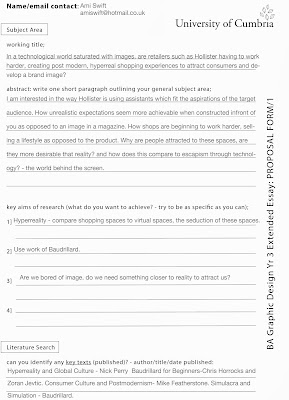RESPONSE:
The context and concepts you mention here are quite well defined but
also a little broad so that over the summer you will have to unpack them and
pick apart in more detailed and assertive ways – still, the focus on Hollister
is excellent and offers lot of potential. The idea of capitalism, consumerism
and post-modern forms of representation and practice are an interesting
hypotheses and I am clear about how far you want to go with this as a critical
/ analytical dissertation which examines the complexities of specific instances
of consumerism, identity and the hyper-real. Whilst the proposal is very well
formed (good start on lit searches
but they also need some clarity – for key texts do some key word searches using
Google books and scholar) all it does up until this point is to offer a rather
general way to conceptualise these issues. Critically locating the three key
areas (1. Capitalism, 2. Consumerism and 3.
Post-modernity) may well offer a better starting point as you need to begin to
look at key critical works in media and cultural study which deal with the
paradigms you are most interested in.
All of this can then be ‘plugged into’ a clear methodology
(questionnaires, interviews etc.) as well as contextual readings of work and
advertising campaigns or branding strategies used by Hollister. Performing some
key word searches at library and/or doing journal searches and clarifying your
methods will enable you to begin to concentrate on just how interesting and at
times well-conceived a more detailed intervention is – the real vs virtual
dimension may well work out as a way to begin. I know this is only a beginning
but keep on unpacking how and why issues complicate one another and reposition
aspects of visual representation. This will have to be well illustrated in your
research blog over the autumn term and you will need to keep it imaginative yet
realistic for the manageability of the project. I think you need to address the logic of the research and
think about information management – A long side of Baudrillards hyper-real perhaps
engage with a concept such as Pierre Bourdieu’s ‘habitus’ and/or think about
Roland Barthes mythologies / semiotics as a critical / theoretical framework
and discourse method as well as thinking about the primary research in more
depth. Also, begin to think about building up a critical and theoretical
knowledge base/dictionary. I like some of the ideas around primary research and
we can discuss in detail when we meet so think about the practicalities of this
too. You need to consult a larger number and variety of academic sources and
try to be as clear as you can about HOW you are going to go about this.
Reading, listing keywords, collecting visual and textual clippings and data
throughout summer and into the autumn term will assist with this and create a
dissertation proposal with far more clarity. Do not hesitate to get in touch if you need more advice.
Gareth Longstaff
June 27th 2013



